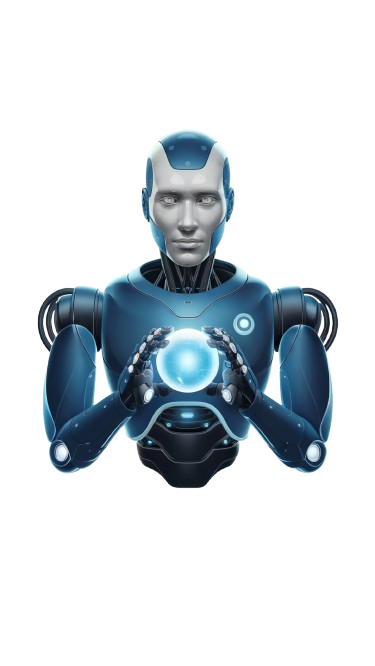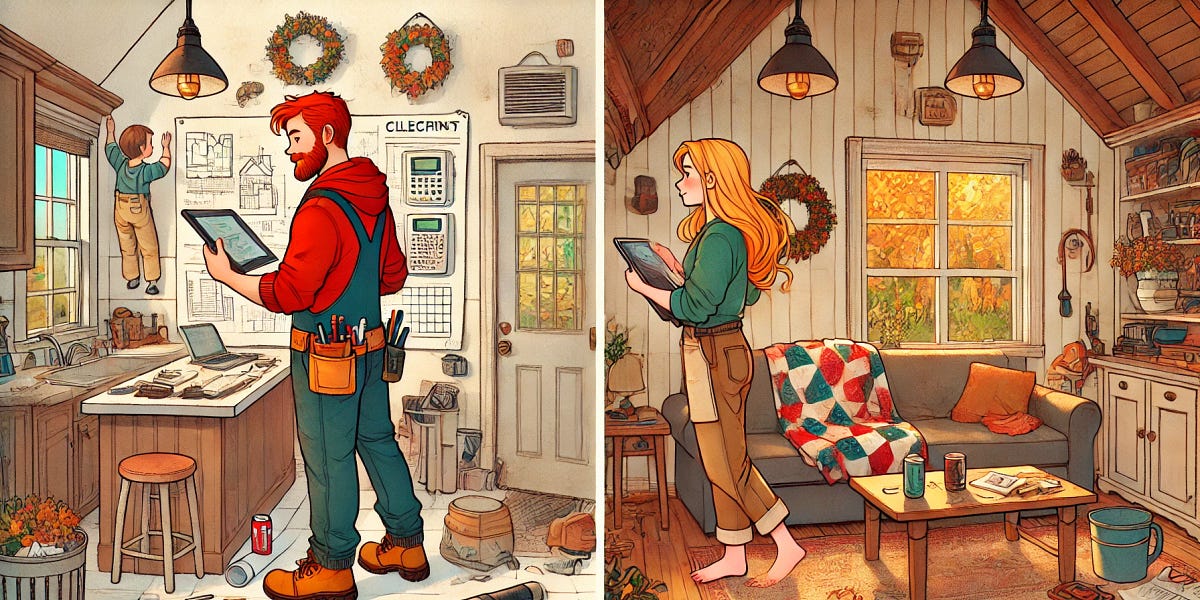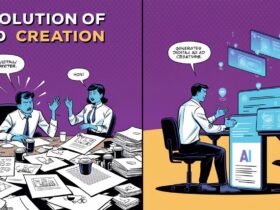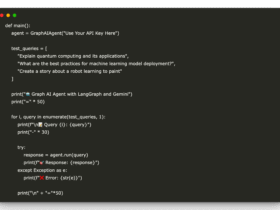
Holly the Holist and Red the Reductionist get married and buy a house together. They need to maintain the house and clean it. They split the set of tasks that need to be done very wisely, so that each gets to do the things they know how to do and enjoy doing.
In what follows, I will, as usual, use the shorthand “a Reductionist” for a person who, when given a complicated problem to solve, prefers Reductionist methods, such as science, planning tasks, constructing things “to measure” from exact drawings, schedules, deadlines, budgets, and the like. The usual Reductionist ideals of Optimality, Completeness, Repeatability, Parsimony, Transparency, and Explainability are part of the requirements. We could not have gone to The Moon without mastering these processes. The keys to Reductionism are the ability to cleanly subdivide complicated tasks and to use Models of Reality that provide computation based predictions of the future. For any complicated problem. In theory.
Similarly, I will use the shorthand “a Holist” for a person who, when given a problem to solve, will just solve it, possibly on the spot, using a good guess which based on a lifetime of personal experience, and without using any explicit Models of the world. No equations, drawings, plans, budgets, or schedules are required. The job just gets done, because we have done it (or something similar to it) before. Just like a Reductionist, we perform an Epistemic Reduction of the problem but we stop when we have found a solution. We do not need to find all solutions or the optimal solution, or to find equations and write computer programs just to tie a knot on a rope. Holists like to build large system by extending small systems, such as adding on another room or building another house nearby, making a haphazard village that grows organically. If they make something, it may well be “built to fit” (rather than “to measure” as Reductionists do) which means artists, crafters, tinkerers, farmers, janitors, etc are often using the Holistic Stance.
I may discuss 30+ differences between the two Stances, and their implications, in future posts. For instance, Reductionists want to be able to enumerate all valid solutions whereas a Holist will just use the first one that “comes to mind”. And Reductionist methods strive for total correctness but Holistic methods provide no guarantees of either completion or correctness.
Reductionism is the use of Models.
Models are Scientific Models, Theories, Hypotheses, Equations,
Laws, Rules, Schedules, Private Models, Superstitions,
and almost all computer programs written before 2001.
Holism is the avoidance of Models.
We note that all problems we want to solve can be triaged, literally, exactly like the original triage in the battlefield. Sparsely available medical attention was focused on those middle cases where it was most effective, leaving obvious survivors and obvious fatalities to their own devices.
Similarly, we “Science” the problems where Science is most useful: in complicated problems, possibly involving many cooperating subcontractors, stakeholders and agents, budgets, deadlines, and long term planning.
There are two other categories of problems beyond those where Science is useful:
-
Simple ones, such as sequencing your leg muscles when taking a step forward or understanding this sentence, where we have enough experience to guess correctly nearly every time.
-
Complex ones. Science can handle complicated problems but not complex ones, because complex problems resist decomposition into subproblems. Protein Folding is an example of this category. I discuss the limits of Reductionism in some of my videos.
So in situations where thousands of parameters interact and we don’t even know what’s important, and we need an answer NOW, we make a guess. And the more experience we have with similar situations, the better the guess will be. And yes, the protein folding algorithms are guessing, based on experience they acquired through machine learning.
Simple problems: Guess!
Complicated problems: Science it!
Complex problems: Guess!
Infants learn how to walk and how to understand a native language, how to tie their shoes, etc. We all do all of our easy everyday problems by guessing. Nobody does science when making breakfast. “What hypothesis did you use when brewing your coffee?”. You do not solve differential equations when braking for a stoplight.
So we see that couples like Holly and Red are a kind of Complementary Pair. One Holist and One Reductionist can solve more problems together than either can do alone. This can be observed in the industry. Many successful companies have started with a pair of founders, where one was more of a Holistic, big-picture feel-good kind of person and the other was highly skilled in some number of relevant technical and scientific fields.
I would claim that pairs like Steve Jobs and Steve Wozniak, Sergey Brin and Larry Page, Sam Altman and Ilya Sutskever all form such complementary pairs. Their startups benefited from their ability to cover more of the enormous conceptual space that is required to launch and run successful products and companies.
So let’s see how Red and Holly subdivide their house maintenance tasks.
Red handles everything that requires planning, schedules, budgets, and the like because he learned The Reductionist Stance in his Engineering (STEM) education. So he handles scheduling the exterminators, and getting permits and plans for the extra tiny house (ADU) in their backyard. He has the bills on autopay and tracks household expenses in QuickBooks. He and a friend are building the ADU using a kit and plans they ordered on the web. This is a lot.
Holly handles everything else. Which is also a lot. She does her part of the maintenance using The Holistic Stance. Because she’s a human, not an engineer.
That sounded bad, but the truth is that the Holistic Stance is the default for humans and has so been since before we were humans. Science is “A Discipline” because it has to be vigilantly and continuously defended against the pollution of haphazard Holistic guesses that are sometimes wrong.
Ironically, there are more Life Sciences than totally hard Reductionist ones like Physics. “Life tends to require a Holistic Stance” is true for all Life Sciences, as well as for our Mundane existence.
Back to the story. To see the contrast more clearly, let’s start with how Red handles the scheduled Fall Cleaning which focuses on the house exterior, infrastructure, cleaning the gutters using the special gizmo he bought on the web, winterizing the HVAC and ensuring they have heating oil, etc. He also goes through each room, methodically, each fall. In one pass he replaces fire alarm batteries, in another he checks that all electrical outlets light the correct lamps on his handy little device, and he washes every window, in order, clockwise, starting with the garage window. Same as last year, because he is using the same spreadsheet to track it all.
Holly’s favorite cleaning style, which she uses every day of the year, is “The Opposite Of Planning”. Huh? Indeed. It is so common there’s a word for it:
putter verb (MOVE). [ I usually + adv/prep ] US; to do things in a relaxed way, without rushing or trying very hard: He really enjoys puttering around in the garden.Holly walks around the house, randomly checking things to make sure everything is OK. When she sees something wrong – a coke can next to the sofa that needs to be gathered and recycled, a counter in the kitchen that needs wiping – she just does it, there and then. No to-do list required.
And she has explicitly declared that if she doesn’t feel like filling the dishwasher, she will stop after emptying it, although in most other households those two tasks are connected. Her Principles of Puttering (if she had any, because Rules are Reductionist) would explicitly state that any task that has been started can be left partially completed to be resumed, or not, at a later date. So large parts, like that quilt she is working on, are done one square at a time, and hurrying the artistic process would be wrong. Holly has no idea when it will be finished.
This Holistic Stance style of problem solving has the opposing advantages and disadvantages from the Reductionist Stance. There are things you cannot do, because you suddenly find you are out of wheat flour. On the other hand, since you didn’t really have a plan, you can just do something else instead of baking. The opportunistic stance can be much more effective in a highly variable constrained environment. If life is complex, do what you can do, here and now. Dig where you stand. You can always do something. In contrast, Reductionists cannot reliably plan anything in complex situations. As an example, any war is like that. “No battle plan survives the first contact with the enemy”, but it is essential that you have one.
We can see how these two stances are each others opposite and if you do not appreciate the advantages of both, the behaviors of people from the other team can be mystifying and sometimes infuriating. “God, woman, how could you not plan for that?” and “Honey, spin down, we’re adults, we can deal with it. Let’s go for a walk”. This deserves a little side note.
In his book by that name, Simon Baron-Cohen voiced the hypothesis that if we consider a spectrum with average people in the middle of the bell curve and autistic people on one edge, then there are people at the other edge with the opposite capabilities and problems from Autistic people.
In High Technology groups it is generally recognized that people towards the Autistic end are more effective Reductionists.
What would people at the other edge, the furthest away from Reductionist Technologists with a hint of autism, look like? Let us describe them with the opposite archetypes of a TechNerd.
They do not understand maps or use spreadsheets. They know 40 names for colors. They worry about insignificant detail, like dinner table arrangements, because they want to. They are creative, and love expressing their creativity in several ways. They are outgoing and gregarious socializers, and are often artists, authors, teachers, full time parents, pet owners, nurses, etc. They can read between the lines and excel at reading people’s emotions. They are empaths. They always know the right thing to say.
I don’t think I’m stretching too far if I observe that everybody is born a Holist but a few people are also born to become good Reductionists after a STEM education, and a few others are born to become exceptional Holists.
Red solves his scheduling problems in an abstract Model space – the to-do list, scheduling app, and spreadsheets – whereas Holly uses the environment itself as her to-do list. She solves problems in the domain they occur, in everyday reality, rather than in an abstract mathematical space.
They live in a country with a yearly moose hunting season. Red goes hunting every fall with some other well-organized friends. Around the campfire they compare their $200+ hunting knives. The knife is the traditional hunter’s tool, and like Reductionism itself, it is used to cut things apart, into manageable parts, as cleanly as possible.
Holly tends a medium sized garden in their backyard. She plants things in the appropriate seasons, going by gut feel and experience, including lore from her parents and other elders, and she is adjusting the planting dates according to local weather, if so required. And every day of the year, she putters around in the garden, pulling off a dead leaf or a weed here and tying up a drooping branch there. She carries a basket, the traditional tool of the Gatherer, and by extension the Holist, gathering whatever is ripe today, and she incorporates whatever she manages to find into their next meal or two. Produce won’t ripen on schedule, so schedules are useless. Better to adjust to the ever changing reality than making detailed plans.
There is one aspect that overrides personal preference when it comes to selecting a problem solving stance.
If the cost of failure is low, feel free to guess, since that is often much cheaper than planning, even if you could use a model. You can cook Reductionistically – you can follow a recipe precisely the first few times, and then, when you understand the dish, you can cook it Holistically – You can wing it without measuring. You can, over time, learn the optimal degree of browning on those scallops, but if you follow the recipe precisely every time, then you cannot learn to improve your execution.
Conversely, if the cost of failure is high, such as a potential loss of life, then we cannot afford to guess because we cannot afford the consequences of guessing wrong.
In our everyday lives, the costs are generally low. Should I bring an umbrella? What’s The Worst That Could Happen? I might get wet. Should I deglaze this pan with sour cream? We might have to order pizza. No big deal, we’re adults, we’ll deal. Even scientifically minded people will use guessing for most everyday problems because it’s much cheaper, starting with requiring less explicit thinking. “Hey, it worked yesterday”.
How do they cooperate? Holly notices ants in the kitchen and tells Red about it. He whips out a phone and makes an entry in a to-do app, because of course he does. He tells her that his brother is getting married and Holly knows what to do, because she is socially well connected, understands traditions and æsthetics, and has an eye for the arts decorations. She has experience with all those things, and can handle social interactions in general with little or no planning, whereas small talk in large crowds makes Red uncomfortable.
How do Complementary Pairs in business cooperate? Perhaps one understands technology, product, and manufacturing. The other, finance, sales, and marketing. Two people in a startup can wear these six hats better than one. They must know enough of the other person’s world to be able to discuss every issue around the borders. And this is where a tightly coupled two person team really shines, because communication between two people is more effective than between six.
In the end, the secret to Holly and Red’s success in life – whether in cleaning their house, running a startup, or navigating life – is not about proving one stance superior to the other. It’s about knowing when to rely on each.
A Reductionist’s precision and planning can build bridges to the moon, while a Holist’s flexibility can thrive in the unpredictable wilderness of our mundane yet complex reality.
So whether you’re tending a garden, building an empire, or cleaning your gutters, remember this: Play to your strengths, but don’t forget to borrow the best from the other team.
It takes both hunters and gatherers to thrive.












